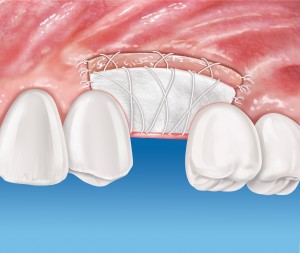New technology sees off “giant transplants”
Do large defects need large transplants? Not always. A new technique cleverly merges
autologous tissue and collagen matrix.
If soft tissue is lacking after major bone augmentations, use is often made of giant
autologous soft tissue transplants from the palate: either free gingival grafts or connective
tissue grafts. Their removal is painful due to the creation of large wound surfaces in the
palate.
Narrow transplant provides cells to the matrix
Prof. Istvan Urban, Hungary/USA, has published a prospective series of cases for an
alternative method1. This involves him using only a narrow free gingival graft of about 2-3 mm
in width and combining it with the Geistlich Mucograft® collagen matrix. The underlying idea:
the autologous transplant, placed apically parallel to the collagen matrix, ensures that the
collagen matrix is replaced by new keratinised tissue instead of by non-keratinising mucosal
cells.
6.33 mm gained
After one year a mean 6.33 mm of keratinised tissue had been gained. Use of analgesics
and patient-reported morbidity were very low.
Details of the case series:
Involvement: 20 patients with at least one site without keratinised tissue in conjunction with
loss of vestibular depth
Primary endpoint: widening the keratinised tissue after 12 months
Secondary endpoints: transplant shrinkage, morbidity after 1 and 2 weeks (use of
analgesics plus measurement using visual analogue scale)
Evaluation: 12 months after surgery
Reference:
1. Urban IA, et al.: Int J Periodontics Restorative Dent 2015; 35(3): 345-53.


